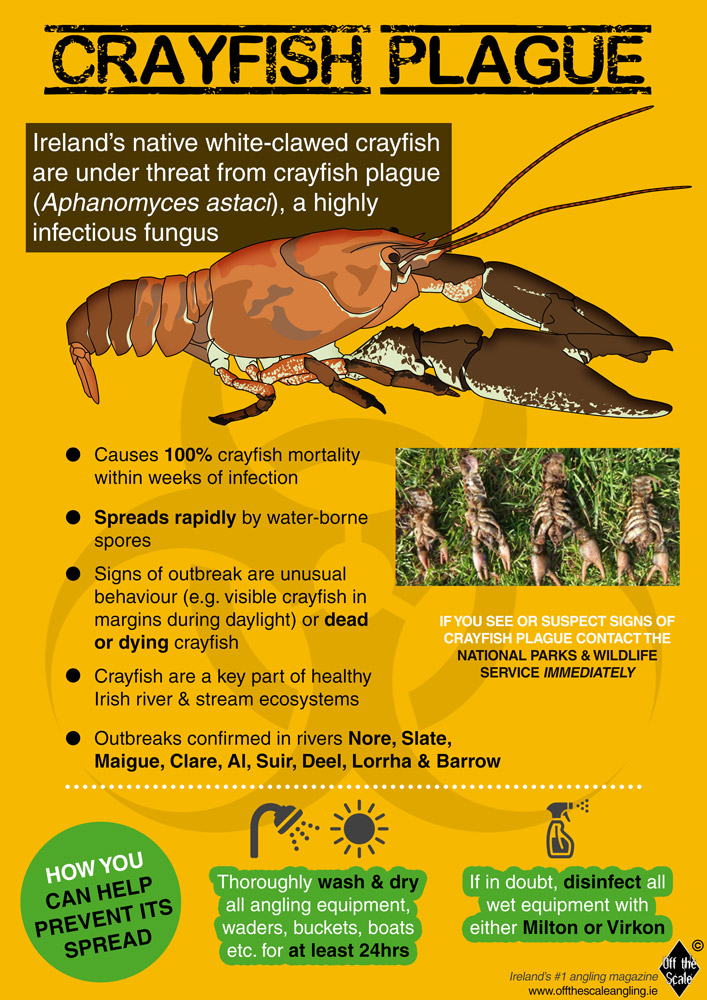
Crayfish plague disease hits River Nore
15th August 2019
An outbreak of crayfish plague, a fungal disease lethal to our native white-clawed crayfish (Austropotamobius pallipes), has been confirmed from the River Nore in Kilkenny. This is the fourth case reported so far in Irish waters in 2019.
Ireland is one of the last strongholds for white-clawed crayfish in the world and was officially considered free from crayfish plague until 2015, when an isolated case was identified on the River Bruskey, Co. Cavan. In 2017 multiple large-scale outbreaks occurred on the Rivers Suir, Barrow, Limerick Deel and Lorrha (Tipperary). A further three outbreaks were detected in 2018; on the Al River at Athlone ; the Blackwater near Aughentaine, Co. Tyrone and a new site on the River Barrow (upstream of previous outbreaks). Outbreaks on the River Clare near Claregalway, the Slate River near Rathangan and the River Maigue near Adare have also been confirmed in 2019.
Regulatory authorities have been heavily criticised for not doing more to prevent further spread of this deadly infection in Irish waters, with waterside signage and voluntary bans on water sports and angling at infected sites the only measures implemented. Public awareness campaigns on the issue continue to be deemed relatively ineffective by many stakeholders.
This most recent outbreak on the River Nore, one of Ireland’s most productive rivers and prime wild salmonid fisheries, is yet another reminder of how fragile our aquatic ecosystems are and that all anglers and water users need to be extra vigilant to prevent the further spread of crayfish plague.
Please follow the clean-check-dry protocol with your gear by cleaning it in hot water, disinfecting and then drying thoroughly in strong sunshine before moving between water bodies (please see our poster below). If you observe any peculiar crayfish behaviour then please contact the NPWS, Waterways Ireland, Inland Fisheries Ireland or this magazine immediately.
What is crayfish plague infection and why should I care?
White-clawed crayfish, which are native to Irish waters, have suffered widespread declines through their European range in recent decades and are offered strict legal protection as an Annex II species under the EU Habitats Direction as a result. The species is also afforded protection under the Irish Wildlife Act (1976, amended 2000). Ireland represents one of the last remaining strongholds for the species. Crayfish are considered a vital part of healthy ecosystems where they occur, recycling organic matter and nutrients as well as providing a rich food source for a whole host of animals, including fish species such as wild brown trout (read more on this here ).
Crayfish plague (Aphanomyces astaci) is a highly infectious fungus which causes 100% mortality in this declining native species. The fungus attaches to thin areas of outer shell (cuticle) as a spore and then grows through the tissues, leading to death in all cases within 2-3 weeks. The swimming spores then transmit directly from the infected or recently dead crayfish to other areas downstream. Spores are easily spread accidentally by anglers and other water users (e.g. canoes, kayaks, boats) through wet gear, and might also be spread inadvertently by water birds and other organisms. The fungus affects the normal vision of the crayfish and so it may be seen crawling around in broad daylight where it usually wouldn’t, although dead crayfish are the obvious sign of infection. Crayfish plague originated in North American crayfish and it is their introduction to Europe which has caused many white-clawed populations to decline. To date no non-native crayfish have been discovered in Irish waters.

